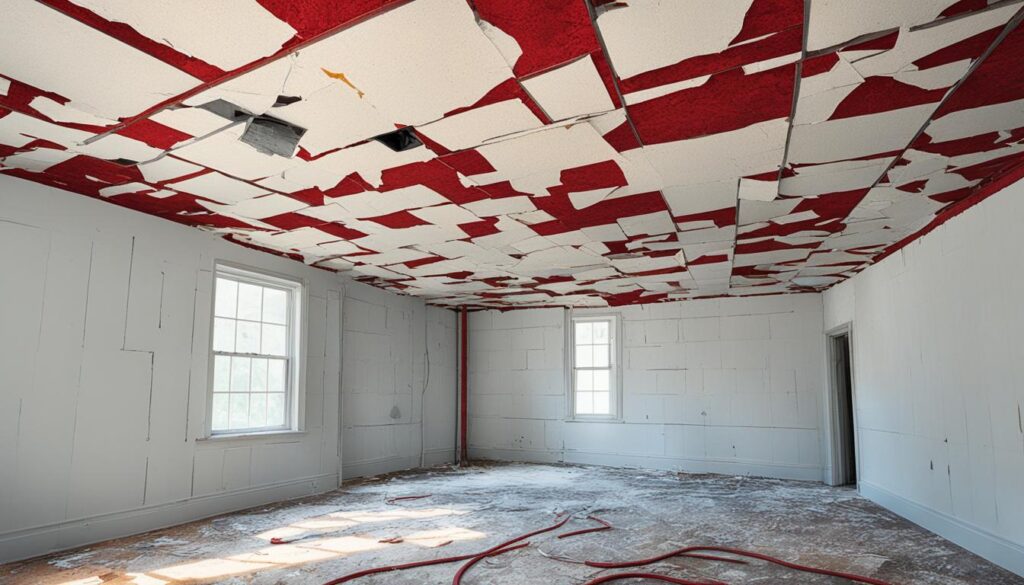Asbestos is a dangerous material used in UK buildings until 2000. It can cause lung cancer and mesothelioma. Many homes in the UK might have it. Learning to spot asbestos in your home is important for your health. This guide will show you how to find asbestos. You’ll learn what signs to look for and why testing for asbestos matters.
Key Takeaways
- Asbestos is a dangerous mineral commonly found in UK homes.
- Identifying asbestos in your property is crucial for your safety.
- Lung cancer and mesothelioma are serious health risks associated with asbestos exposure.
- Proper asbestos testing is essential to determine the presence of asbestos.
- Seeking professional help for asbestos identification and removal is recommended.
Signs of Asbestos in Your Home: How to Spot the Presence of Asbestos
If you’re worried about asbestos in your home, look for certain signs. Spotting asbestos isn’t easy without a professional, but some clues may point to it.
Age of Your Building
Think about when your building was made. Asbestos was often used in buildings before the 1980s. If your home is from this time, it might contain asbestos.
Insulated Materials
Insulation in your home could be a sign. Asbestos was used in old pipes and boilers. Look for insulation that’s fluffy like cotton. It might mean there’s asbestos.
Interior Wall Paint and Ceilings
Asbestos was in some wall paints and ceilings too. A textured finish might have asbestos. This was because it’s good for stopping fires and blocking noise.
Wood Stoves and Fireplaces
Wood stoves and fireplaces installed before the 1990s may have used asbestos. Insulation or gaskets that look worn need a professional check.
Window Putty, Cars, Garden Sheds, and Garages
Window putty and older car parts might have asbestos. Sheds and garages too. Asbestos was chosen for its strength and resistance to heat. Be careful when fixing these.
Drywall, Floor Tiles, and Carpet Underlay
Materials like drywall, made before the 1990s, may have asbestos. If they’re damaged, asbestos fibers can get into the air. Handle with care and get expert advice.
Home Siding, Water Heaters, and Air Conditioning or Heating Ducts
Home siding and water heaters can contain asbestos. The same for air conditioning ducts. They were used for their insulation. If you have an older home, get it checked.
Remember, these signs don’t prove asbestos is there, only professional tests can. Still, if you see these signs, be cautious and seek expert help for testing and removal.

| Signs of Asbestos in Your Home | Indicators |
|---|---|
| Age of Your Building | Construction before the 1980s |
| Insulated Materials | Fibrous insulation resembling loose, fluffy ash or cotton |
| Interior Wall Paint and Ceilings | Textured or stippled finishes |
| Wood Stoves and Fireplaces | Worn or damaged insulation or gaskets |
| Window Putty, Cars, Garden Sheds, and Garages | Older materials with asbestos components |
| Drywall, Floor Tiles, and Carpet Underlay | Materials used before the 1990s |
| Home Siding, Water Heaters, and Air Conditioning or Heating Ducts | Asbestos-containing materials in older properties |
Friable and Non-Friable Asbestos: Understanding the Different Types of Asbestos
Knowing the types of asbestos and their health risks is key. There are mainly two sorts: friable and non-friable asbestos.
Friable Asbestos
Friable asbestos can be easily damaged, sending dangerous fibers into the air. This type is risky because the fibers can be breathed in, causing lung issues. Things like asbestos insulation and sprayed-on coatings are examples of friable asbestos.
We must be very careful with friable asbestos to reduce exposure risks. If disturbed without the right safety gear, it can endanger everyone nearby.
Non-Friable Asbestos
Non-friable asbestos, or bonded asbestos, holds together better, making it safer. It’s mixed with cement or resin, which helps prevent the fibers from escaping. Asbestos cement sheets and floor tiles are common non-friable materials.
This type poses less of an immediate risk, but caution is still needed. Once damaged, non-friable asbestos can become friable and dangerous.
Ensuring Safety with Asbestos Handling and Removal
Distinguishing between friable and non-friable asbestos helps in managing them safely. Always get professionals for any asbestos work. They know how to deal with asbestos while keeping everyone safe.
Making safety a priority and taking the right steps can shield you and others from asbestos hazards.

Conclusion: Ensuring Your Safety and Taking Action
Asbestos in your home can seriously harm your health. It’s vital to spot and deal with any asbestos early. If you think your house might have asbestos, get expert help for tests and removal. This way, you keep everyone safe.
Asbestos is a hidden danger with long-term effects on health. Testing for asbestos gives you the info needed to make smart choices. Also, experts can remove asbestos safely, cutting the risk of exposure.
Taking quick and expert action is essential to avoid asbestos health problems. Our team in the UK is ready to remove asbestos properly. We focus on your safety and make sure asbestos is fully removed from your home.
Don’t let the asbestos threat turn into reality. Start protecting your safety today. Contact us for asbestos checks and removal. Together, we’ll make your surroundings safer for everyone.
